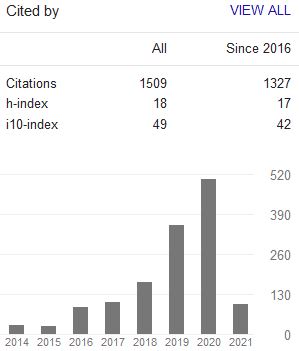THE EXPANSION OF JAMA’AH TABLIGH MOVEMENT AND ITS INFLUENCE ON THE RELIGIOUS BELIEF OF THE BAJO PEOPLE IN SOUTH EAST SULAWESI
Abstract
Keywords
Full Text:
PDFReferences
Ahimsa-Putra, H.S. Minawang: Hubungan Patron-Klien di Sulawesi Selatan. Yogyakarta: Gadjah Mada University Press, 1988.
Al-Qurtuby, Sumanto. “Indonesia’s Islamist Mobilization.” Kyoto Review of Southeast Asia (2018).
Aziz, Abdul. “The Jama’ah Tabligh Movement in Indonesia: Peaceful Fundamentalist.” Studia Islamika 11, 3 (2004).
Baskara, Benny. Islam Bajo: Agama Orang Laut. Jakarta: Javanica, 2016.
Baytiyeh, H. and Naja, M. “The Effects of Fatalism and Denial on Earthquake Preparedness Levels.” Disaster Prevention and Management 25, 2 (2016).
Bustaman-Ahmad, Kamaruzzaman. “The History of Jama‘ah Tabligh in Southeast Asia: the Role of Islamic Sufism in Islamic Revival.” Al-Jami‘ah 46, 2 (2008).
Firmansyah, A. “Manajemen Kurikulum Pondok Pesantren Salafiyah Dalam Penyelenggaraan Program Dakwah Jamaah Tabligh.” Zawiyah 4, 1 (2018).
Hamdy, S. “Islam, Fatalism, and Medical Intervention: Lessons from Egypt on the Cultivation of Forbearance (Sabr) and Reliance on God (Tawakkul).” Anthropological Quarterly 82, 1 (2009).
Hortsmann, A. “The Tablighi Jama'at, Transnational Islam, and the Transformation of the Self between Southern Thailand and South Asia.” Comparative Studies of South Asia, Africa and the Middle East 27, 1 (2007).
Kayani, A., MJ. King, and JJ. Fleiter. “Fatalism and Road Safety in Developing Countries, With a Focus on Pakistan.” Journal of the Australasian College of Road Safety 22, 2 (2011).
Khawiyu, Abdul. “Pemberian Nafkah Terhadap Keluarga, Studi Kasus Aktifitas Khuruj Jama’ah Tabligh di Kota Kendari.” Jurnal Syariah Hukum Islam 2, 1 (2019).
Lapian. A.B. Orang Laut, Bajak Laut, Raja Laut: Sejarah Kawasan Laut Sulawesi Abad XIX. Depok: Komunitas Bambu, 2009.
Liow, J.L. “Islamism in Southeast Asia.” Kyoto Review of Southeast Asia 23 (2018).
Littlewood, R. and S. Dein. “Islamic fatalism: Life and Suffering among Bangladeshi Psychiatric Patients and Their Families in London.” Anthropology & Medicine 20, 3 (2013).
Mahali, Saidatul Nornis Hj. “Latar Masyarakat Bajau”. Saidatul Nornis Hj. Mahali (ed.). Bajau Pantai Barat. Sabah: Universiti Malaysia Sabah, 2012.
Nagatsu, K. “Maritime Diaspora and Creolization: Genealogy of the Sama-Bajau in Insular Southeast Asia.” Senri Ethnological Studies, 95 (2017).
----------. “Social Space of the Sea Peoples: A Study on the Arts of Syncretism and Symbiosis in the Southeast Asian Maritime World.” The Journal of Sophia Asian Studies, 33 (2015).
Noor, Farish A. “Conversion Narratives and the Appropriation of India in the Southeast Asian Tablighi Jama‘at Movement.” Michael Feener and Terenjit Sevea (eds.). Islamic Connections: Studies of Muslim South and Southeast Asia. Singapore: ISEAS, 2008.
----------. “Pathans to the East! The Development of the Tablighi Jama'at Movement in Northern Malaysia and Southern Thailand.” Comparative Studies of South Asia, Africa and the Middle East 27, 1 (2007).
----------. “The Arrival and Spread of the Tablighi Jama‘at in West Papua (Irian Jaya), Indonesia.” RSIS Working Papers Series no. 191, Nanyang Technological University, Singapore, 2010.
----------. “The Spread of the Tablighi Jama‘at across Western, Central, and Eastern Java and the Role of the Indian Muslim Diaspora.” RSIS Working Papers Series no. 175, Nanyang Technological University, Singapore, 2009.
----------. “The Tablighi Jama‘at in the Southern Provinces of Thailand Today: Networks and Modalities”. RSIS Working Papers Series no. 174, Nanyang Technological University, Singapore, 2009.
----------. Islam on the Move: The Tablighi Jama’at in Southeast Asia. Amsterdam: Amsterdam University Press, 2012.
Pelras, C. The Bugis. Oxford: Blackwell Publishers, 1996.
Rahim, Md. Saffie Abd. and Ramzah Dambul. “Identiti Etnik Bajau Pantai Timur.” Md. Saffie Abd. Rahim, Sabihah Osman, and Ramzah Dambul (eds). Bajau Pantai Timur. Sabah: Universiti Malaysia Sabah, 2012.
Ringgren, H. “Islamic Fatalism.” Helmer Ringgren (ed.). Fatalistic Beliefs in Religion, Folklore, and Literature. Stockholm: Almqvist & Wiksell, 1967.
Saat, Gusni. Sama Bajau dalam Kanca Urbanisasi: Pengalaman di Teluk Bone, Sulawesi Selatan. Kuching: Universiti Malaysia Sarawak, 2010.
Sakdiah. “Masthurah dalam Dakwah Jama’ah Tabligh: Analisis Metode dan Praktek.” Al-Idarah 1, 1 (2017).
Saprillah. “Gerakan Salafisme di Kota Kendari.” Mimikri 3, 1 (2017).
Siddik, Ibnu Radwan. “The Husband’s Obligation in Giving Religious Education for His Wife According to Compilation of Islamic Law and its Implementation on Tablighi Jama’at in Serdang Bedagai, North Sumatra, Indonesia.” IOSR Journal Of Humanities And Social Science 22, 4 (2017).
Sila, M. Adlin. “Kasus Jama’ah Tabligh di Makassar Sulawesi Selatan dan Magetan Jawa Timur.” Ahmad Syafi’í Mufid (ed.). Perkembangan Paham Keagamaan Transnasional di Indonesia. Jakarta: Kementerian Agama, 2011.
Simsekoglu, O. et.al. “Risk Perceptions, Fatalism and Driver Behaviors in Turkey and Iran.” Safety Science 59 (2013).
Talib, M. “The Tablighis in the Making of Muslim Identity.” Mushirul Hasan (ed.). Islam, Communities and the Nation, Muslim Identities in South Asia and Beyond. New Delhi: Manohar Publishers, 1998.
Wahid, Abdurrahman. Ilusi Negara Islam: Ekspansi Gerakan Islam Transnasional di Indonesia. Jakarta: LibForAll Foundation, 2009.
Zacot, F.R. Orang Bajo, Suku Pengembara Laut. Jakarta: Gramedia, 2008.
DOI: 10.15642/JIIS.2020.14.2.519-540
Refbacks
- There are currently no refbacks.
Indexed by:
Journal of Indonesian Islam (ISSN 1978-6301 and E-ISSN 2355-6994) is published by the Postgraduate Program (PPs) and the Institute for the Study of Religion and Society (LSAS), State Islamic University (UIN) of Sunan Ampel Surabaya.
Journal of Indonesian Islam by http://jiis.uinsby.ac.id/index.php/JIIs/index is licensed under a Creative Commons Attribution-ShareAlike 4.0 International License.
Copyright ©2020 State Islamic University (UIN) of Sunan Ampel Surabaya. Powered by Public Knowledge Project OJS.







